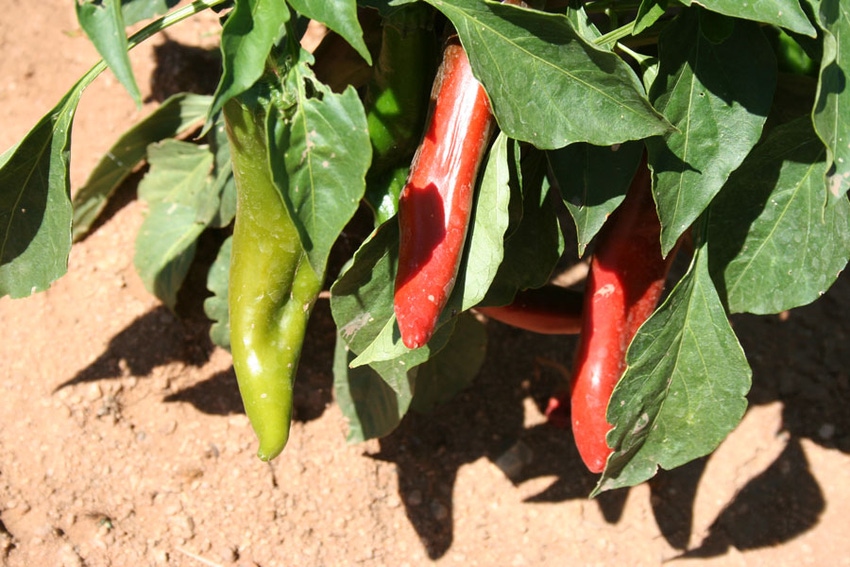
As Hatch chiles ripen and harvest moves into full swing across New Mexico, the state's famed green chile industry is struggling to keep its head above water as 21st Century challenges threaten to push the industry into further decline.
According to USDA-NASS figures, the state's chile industry last year reached a 43-year low in overall chile production, and prospects for recovery balance on a thin line of developments that could send the industry either up or down, which in turn could be the deciding factor on whether or not there will be a next generation of chile growers to produce its annual spicy crop.
Water for irrigation, foreign and domestic competition and an ever-growing challenge to get declining acres of the state's chile crop harvested before it spoils pose a deadly trio of problems the industry is facing in modern times.
Until last year, five years of drought were wreaking havoc on the availability of irrigation water for chile producers, but El Niño-driven rains provided adequate water beginning in late 2014 and into this year to allay those worries, at least for the immediate future.
For the latest on southwest agriculture, please check out Southwest Farm Press Daily and receive the latest news right to your inbox.
The state launched a campaign to better market locally grown chile to consumers both in and out of state last year, and those efforts have met with some early success, helping the state's chile growers to compete with foreign-grown chile producers and new domestic competition from Arizona, Texas and Colorado.
Labor challenge
But the problem of hand picking fragile chiles, which are subject to bruising, a condition that destroys the shelf life of the crop even before it can reach out-of-state markets, is a challenge with potential to decimate the industry. That's why New Mexico Chile Commission Chairman Rick Ledbetter says finding an adequate number of chile pickers to harvest the annual crop is greatest challenge the industry currently faces.
Ledbetter, who farms in Portales, grows only enough chile for his own needs because, faced with the multiple challenges of the industry, he can no longer grow them commercially.
That sentiment runs deep among the state's chile producers. Hatch-area grower Jerry Franzoy has been warning agricultural officials for years that farm labor is the single greatest challenge of the New Mexico chile industry. Hand picking the crop is labor intensive, and without meaningful immigration reform, the prospect of a successful New Mexico chile industry is a year-to-year concern.
Stricter immigration enforcement by federal authorities has cut down on the number of Mexican immigrants who cross into the U.S. and achieve residency status, and that labor force is needed if the industry is to survive.
"If something doesn't happen soon, we're going to be in trouble for picking chile," he said, referring to stalled immigration legislation in Washington.
Chris Biad of Biad Chili Company of Messilla Park, New Mexico, agrees.
"The Hatch green chile is growing in popularity rapidly and demand is growing as well," Biad said. But he warns that the increasing difficulty in finding enough farm workers during harvest threatens his operation and just about every chile producer in the state.
"We have been hoping for immigration reform that includes a meaningful farm worker program, but because chile must be harvested by hand, finding enough farm labor is a problem we will face each year," he added.
Ed Ogaz, another Hatch Valley chile grower, says the best hope of saving New Mexico's chile industry is a return to the U.S. Labor Department's Bracero program, a guest worker program that between 1942-1964 allowed millions of Mexican immigrants to work on U.S. farms.
Bring Back Braceros
"I think we need a new Bracero program," Ogaz recently told a meeting of chile growers.
As it stands now, chile and onion growers are competing for a small pool of available farm workers, and the system is penalizing everyone.
Opponents to a guest worker program specific to a single industry, however, point out that two programs already operate under the U.S. Citizenship and Immigration Service (USCIS), which is responsible for managing the agency's Green Card program.
According to the USCIS, the H-2A worker program allows U.S. employers who meet specific regulatory requirements to bring foreign nationals to the U.S. to fill temporary agricultural jobs, and the H-2B program allows U.S. employers to bring foreign nationals to the U.S. to fill temporary nonagricultural jobs.
But chile growers say the only program they could qualify for would be the H-2A worker program, and H2-A provides a maximum qualification of only three years. Without immigration reform, that leaves little hope for an industry that has already used all the programs available through existing laws.
As chile harvest in New Mexico peaks, growers hope they can harvest their reduced crops before they over-ripen in the fields, and say they are holding out hope Congress will eventually pass immigration reform that will help the industry to keep its head above water in the years to come.
But with elections looming next year and immigration reform a trigger issue for both major parties, many growers say they don't feel their odds are the best.
About the Author(s)
You May Also Like




